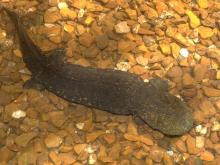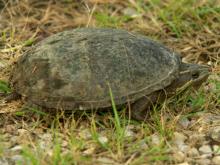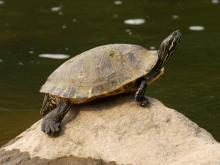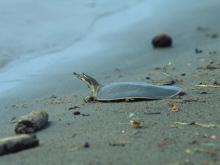Reptiles and Amphibians
Media

Species Types
Scientific Name
Siren intermedia nettingi
Description
The western lesser siren is an eel-like, aquatic salamander with external gills, small eyes, small forelimbs with four toes, and no hind limbs. In Missouri, it’s found mostly in the Bootheel and northward in counties near the Mississippi River.
Media

Species Types
Scientific Name
Opheodrys aestivus aestivus
Description
The northern rough greensnake is a long, slender snake common in the Ozarks. It is light green above with a white or yellowish belly. The scales on the back have small ridges that feel rough to the touch. Its beautiful green color helps this mild-mannered insectivore blend in with tree leaves.
Media

Species Types
Scientific Name
Necturus maculosus maculosus
Description
Mudpuppies are aquatic salamanders that have plumelike external gills throughout their entire lives. They’re found in the southern half and along the eastern edge of Missouri.
Media

Species Types
Scientific Name
Cryptobranchus alleganiensis alleganiensis
Description
The eastern hellbender is a large, entirely aquatic salamander with a wide, flat head, small, lidless eyes, and soft folds of skin on the sides. In Missouri, it occurs in the northern Ozark highlands in spring-fed rivers that drain north into the Missouri and Meramec river drainages.
Media

Species Types
Scientific Name
Sternotherus odoratus
Description
The eastern musk turtle is one of the world’s smallest turtles. It has a dark, domed upper shell and reduced lower shell. It occurs along our Mississippi River counties and in the southern two-thirds of the state.
Media

Species Types
Scientific Name
Pseudemys concinna concinna
Description
The eastern river cooter is a broad-shelled aquatic turtle with a seemingly small head. It is most abundant in the rivers and sloughs of southern Missouri but also occurs in some of our large reservoirs.
Media

Species Types
Scientific Name
Apalone spinifera spinifera
Description
The eastern spiny softshell is a medium to large softshell turtle with small bumps or spines on the front edge of the upper shell. There are dark spots on the fore- and hind limbs.
Media

Species Types
Scientific Name
Apalone mutica mutica
Description
The midland smooth softshell is a rather plain-looking softshell turtle, with a smooth, rather featureless olive-gray or brown shell, and a light stripe bordered by black extending backward from each eye.
Media

Species Types
Scientific Name
Graptemys geographica
Description
The northern map turtle is a medium-sized aquatic species with a low ridge along the center of the upper shell. A small yellow spot is present behind each eye. It occurs mainly in the Ozarks and the upper Mississippi River in northeastern Missouri.
Media
Species Types
Scientific Name
Graptemys ouachitensis
Description
The Ouachita map turtle is a medium-sized aquatic species with a prominent ridge down the center of the upper shell and bright yellow lines on the head and limbs. A large yellow marking behind each eye extends, narrowing, on top of the head. It occurs in southern and eastern Missouri.
See Also
About Reptiles and Amphibians in Missouri
Missouri’s herptiles comprise 43 amphibians and 75 reptiles. Amphibians, including salamanders, toads, and frogs, are vertebrate animals that spend at least part of their life cycle in water. They usually have moist skin, lack scales or claws, and are ectothermal (cold-blooded), so they do not produce their own body heat the way birds and mammals do. Reptiles, including turtles, lizards, and snakes, are also vertebrates, and most are ectothermal, but unlike amphibians, reptiles have dry skin with scales, the ones with legs have claws, and they do not have to live part of their lives in water.





















